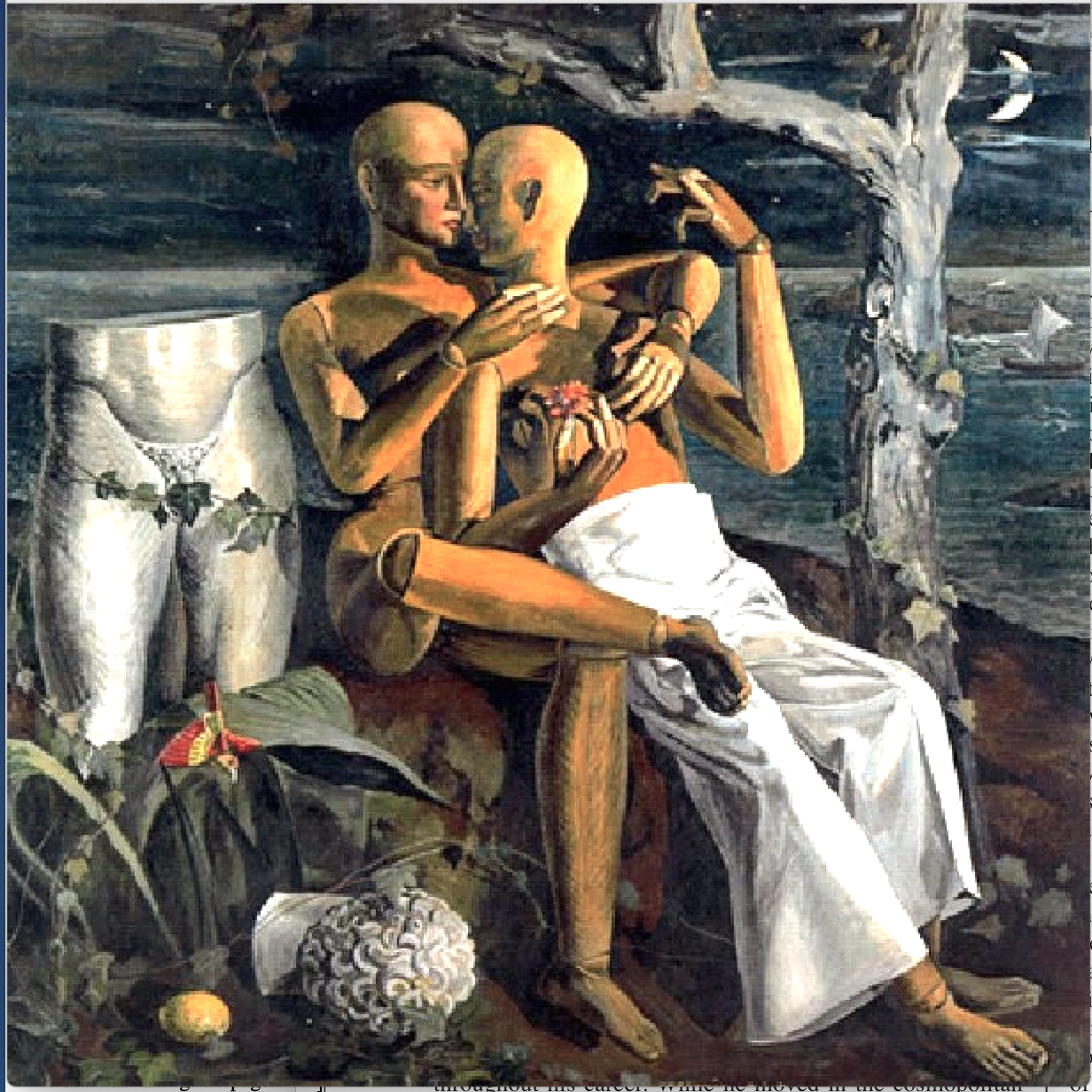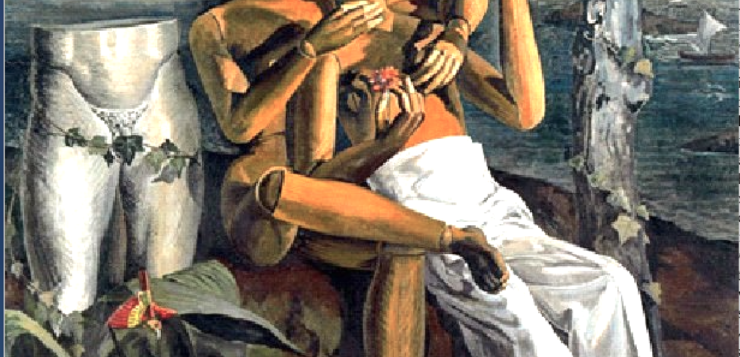Prieto lived and worked through a turbulent series of events for both Spain and the world: the incomprehensible slaughter of lives in two world wars, the founding of the Spanish Republic, the ensuing brutality of the Spanish Civil War, and the Blitz in London. But he was also present for the rise of the modern liberation movements, including Gay Liberation, as well as the restoration of Spanish democracy in 1975.
By 1948, Prieto had made his separate peace with the Franco regime and returned to Spain to resume his career, and he achieved a certain sense of artistic recognition and respectability in the art scene of postwar Spain. And yet, perhaps by winning the war he had lost the peace, suffering what every artist dreads, consignment to a regional following: a kind of exile. At the time of his death at age 95 in a democratic Spain, an obituary in one of Spain’s leading newspapers, El País, read (Nov. 15, 1992): “Forgotten at the Reina Sofía.”
When the permanent collection of modern Spanish art was being installed at the Queen Sofia National Museum of Modern Art in Madrid, Prieto’s works were completely ignored and dropped from the original contemporary art collection. One can only speculate as to the reasons for this omission. Certainly one of them could be that his later works, which included a lot of landscapes of La Mancha’s windmills, didn’t sustain the vibrancy of his earlier years as part of “La Vanguardia” and as a chronicler of the famed Generation of 1927. Several articles in the same paper went on to note his treatment of such subjects as his stylized mannequins, androgynous figures, sailors, and characters among Roman and Greek ruins set in a fabled Mediterranean world. These articles reminded me of my first encounter with the vein of homoerotic themes explored in his paintings, photographs, and later collages from his “Postismo” period, when he was an heir to postwar surrealism.
When Prieto’s works were collected, critics tended to emphasize the “narcissistic qualities” of many of his early pieces. Not surprisingly, considering the times, they said nothing at all about any homoerotic sensibilities in his works. These observations seemed to satisfy the Spanish public of the 1960s and ’70s, and indeed it gave the artist the ability to continue creating during difficult times (the final years of the Franco era).
For posterity, Gregorio Prieto’s works speak for themselves, part of a mythical golden age, capturing the vibrancy of the famed Spanish avant-garde known as the Generation of 1927. Prieto brought an emerging homoerotic presence to the movement that was also present in some of his contemporaries, notably two poets: Federico García Lorca and Luis Cernuda. The Generation of ’27 brought together a rare and exciting constellation of artists, poets, playwrights, cinematographers, and social thinkers—Spain’s answer to England’s Bloomsbury group, Germany’s Bauhaus, and artistic movements of the time such as Dada and Surrealism. These and other schools were thriving until the intellectual life of Europe began to unravel in the maelstrom of World War II.

The Spanish Civil War of 1936–39, a precursor to World War II, took a disastrous toll on the Generation of ’27, what with the assassination of the great poet Lorca, among so many other deaths, incarcerations, and exiles that amounted to a diaspora. In 1937, Prieto showed his works—including the sensual Luna de Miel en Taormina, which depicts two sailor mannequins in a gripping embrace—at the Spanish Republic Pavilion in the International Paris Exhibition, which in itself became a political act.
While today’s non-Hispanic world may not be familiar with that generation’s intellectual and artistic achievements, their contribution to an emerging gay consciousness was tremendous, especially from a Mediterranean standpoint. Prieto’s visual works were rooted in his homeland and studies in France and Italy (as a recipient of the Prix de Rome) and six years of work in Mussolini’s Rome. His paintings and drawings provide a fascinating glimpse into the culture of those pre-Spanish Civil War years, revealing a lively sense of discovery and a surprising degree of tolerance.
Today, to view some of Prieto’s important works you must go to his hometown of Valdepeñas in La Mancha, about 120 miles south of Madrid, where you’ll find the museum that houses the bulk of his works. It was established by the Gregorio Prieto Foundation in 1984. A selection of his more innovative works that were in the old Spanish contemporary art museum, even during the Franco epoch, never made the transition to the nationally visible Reina Sofía Museum of Modern Art in Madrid.
My own discovery of Prieto’s works occurred on a visit to the old Spanish Contemporary Art Museum, which was then located at the University of Madrid, specifically when I viewed the stunning painting titled Center of the World. This large figurative painting encapsulated several of Prieto’s lyrical and visionary themes. They crossed between a mythical Mediterranean world and a visually engaging composition of classical figures. Emanating from the painting was something that tripped my “gaydar” that made the interaction even more profound and compelling. So jarring was the experience that it triggered a several-year quest to find out everything I could about the painter, his milieu, and his other works.
This sense of discovery was also an entry into the fascinating social dynamics and intellectual life of Spain in the 1920s and 30s. Prieto’s works became a visual chronicle of the epoch. He was given the label “Poesia en linea” by poet and Nobel Laureate Vincente Aleixandre, referring to his sensual line drawings and lyricism. His sketches and oils, including the more homoerotic pieces, incorporate a lyrical and sensual flow. His paintings of the 1920s and ’30s are engaging and sensually satisfying, which in itself is a powerful artistic statement in light of the standards of the times. Also, they are refreshingly integrated pieces in an age of fractured representations.
At the same time, Prieto’s portraits and illustrations also represent a rich engagement with their times, including his period in exile, which include sketches and illustrations from before World War II, during his Oxford and London years. Important too, and usually overlooked in contemporary Anglophone research, are his books about and sketches of Lorca and Cernuda, among others, who were members of the Generation of ’27.
Except for an eclectic but extensive series of art books produced or edited by Prieto himself, not much is available regarding any sexual relationships he may have had. Given the state of gay repression both in England and Spain at this time, and also his marketability as an artist, the attitude seems to have been: the less said about this feature of his work, the better. Fortunately, his paintings spoke and continue to speak for themselves.
Prieto’s paintings and writings provide an intimate portrait of several artists and writers that’s missing from formal biographies. Leading Lorca scholars make scant reference to Prieto, while Prieto left behind several books, letters, sketches, and memorabilia relevant to his relationship with Lorca. The same holds true for his special friendship with Luis Cernuda, whose acceptance of his own homosexuality predated any sort of gay liberation by many years. Their lives interconnected in exile and during the Blitz in London, but they went their separate ways after the war.*
In 1997, an exhibition featuring this unique friendship titled Cernuda, Lorca, and Prieto was held upon the centenary of the painter’s birth at the famed student “Residencia” in Madrid, where the three first met—among others of that generation, including Dalí and film director Luis Buñuel. The residency had served as their collective salon and intellectual center. The exposition revisited the intense intellectual engagement of the Generation of 1927.
Today, Spain’s social and cultural isolation during the Franco era has been replaced by a more global perspective. Yet the roots of contemporary Spanish art have an expansive tradition, from the more classical periods found at the Prado through the lesser-known dynamics and the bold cultural rebellion of the 1920s. The Spanish art scene has moved beyond the figurative lyricism and neo-surrealism of Prieto’s œuvre in favor of Picasso, Miró, Gris, and even Dalí. However, one area that has yet to be explored is his contribution, and that of others in his generation, to a Mediterranean vision of an integrated gay consciousness. Luis Cernuda summed up Prieto’s passion in a preface to an English retrospective of his works: “The first essential for understanding reality and for making it live is to love it.” That feeling resonates still, particularly among Prieto’s early works, which were unencumbered by life’s compromises.
* Some of Prieto’s books highlight his critical interest in other artists. The large body of works by Prieto includes: Lorca En Color, Cernuda En Linea, Lorca Y Su Mundo Angélico, and Exposicion Antologica De Gregorio Prieto. In addition, there are a number of fleeting references to Prieto by several Lorca scholars.
Ken Borelli is a child welfare and immigration consultant based in San Jose, CA.






